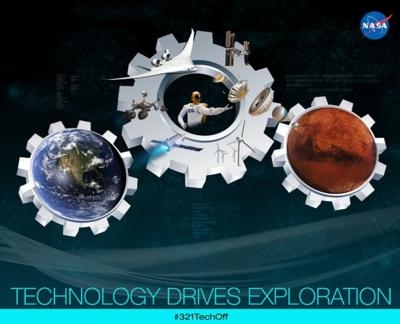Sun, Apr 12, 2015
Three Companies To Manufacture Components For Future Aerospace Vehicles
NASA has selected three proposals to develop and manufacture ultra-lightweight (ULW) materials for future aerospace vehicles and structures. The proposals will mature advanced technologies that will enable NASA to reduce the mass of spacecraft by 40 percent for deep space exploration.

"Lightweight and multifunctional materials and structures are one of NASA's top focus areas capable of having the greatest impact on future NASA missions in human and robotic exploration," said Steve Jurczyk, associate administrator for the agency’s Space Technology Mission Directorate in Washington. "These advanced technologies are necessary for us to be able to launch stronger, yet lighter, spacecraft and components as we look to explore an asteroid and eventually Mars."
Composite sandwich structures are a special type of material made by attaching two thin skins to a lightweight core. Traditional composite sandwich structures incorporate either honeycomb or foam cores. This type of composite is used extensively within the aerospace industry and in other applications making it possible for future journeys to Mars. The ULW materials being developed by NASA vary significantly from traditional cores and are expected to result in a significant decrease in mass.
The three awards selected for contract negotiations are:
HRL Laboratories LLC of Malibu, California: Ultralight Micro-truss Cores for Space Launch Systems
ATK Space Systems LLC of Magna, Utah: Game Changing Technology Development Program Ultra-Light Weight Core Materials for Efficient Load Bearing Composite Sandwich Structures
Dynetics Inc. of Huntsville, Alabama: Ultra-Lightweight Core Materials for Efficient Load-Bearing Composite Sandwich Structures
Phase I awards of the solicitation are valued up to $550,000, providing awardees with funding for 13 months to produce 12-by-12-by1-inch ULW core panels. Technologies selected to continue to Phase II will demonstrate the ability to scale up to 2-feet by 2-feet by 1-inch and ultimately to produce 10-feet by 11-feet by 1-inch ULW core panels, with NASA providing up to $2 million per award for up to 18 months.
More News
Its Offerings Are Lighter, Cleaner, and Now Pushing Past 1,000nm on SAF Jet Fuel DeltaHawk’s diesel-powered aircraft lineup has seen incredible upgrades over the last few yea>[...]
The Airplane Experienced A Total Loss Of Engine Power On December 3, 2025, about 1600 central standard time, a Mooney Aircraft Corp. M20K, N57229, was substantially damaged when it>[...]
Make Sure You NEVER Miss A New Story From Aero-News Network Do you ever feel like you never see posts from a certain person or page on Facebook or Instagram? Here’s how you c>[...]
Aero Linx: European Society of Aerospace Medicine (ESAM) As a pan-European, independent forum, it works to promote the safety and health of all persons involved in aviation and spa>[...]
“We are excited to see Wisk achieve this milestone, and I’m so proud of the team that made it possible. The team at Wisk has built advanced technologies across flight c>[...]
 Aero-TV: DeltaHawks Diesel Power Steps Into the Spotlight
Aero-TV: DeltaHawks Diesel Power Steps Into the Spotlight NTSB Prelim: Mooney Aircraft Corp. M20K
NTSB Prelim: Mooney Aircraft Corp. M20K ANN FAQ: Turn On Post Notifications
ANN FAQ: Turn On Post Notifications ANN's Daily Aero-Linx (12.20.25)
ANN's Daily Aero-Linx (12.20.25) Aero-News: Quote of the Day (12.20.25)
Aero-News: Quote of the Day (12.20.25)



